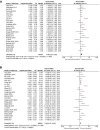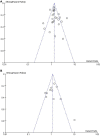Potential impact of platelet-to-lymphocyte ratio on prognosis in patients with colorectal cancer: A systematic review and meta-analysis
- PMID: 37051571
- PMCID: PMC10083474
- DOI: 10.3389/fsurg.2023.1139503
Potential impact of platelet-to-lymphocyte ratio on prognosis in patients with colorectal cancer: A systematic review and meta-analysis
Abstract
Background: Numerous studies have confirmed that inflammation promotes the occurrence, development and prognosis of colorectal cancer (CRC).
Objective: This study focuses on the potentially prognostic value of the platelet-to-lymphocyte ratio (PLR) in CRC patients.
Data sources: This study was registered at PROSPERO (ID: CRD42020219215). Relative studies were searched on PubMed, Cochrane Library, Embase, Web of Science, and clinical trial databases by two back-to-back reviewers. Study Selection and Intervention: Studies were screened according to the predetermined inclusion and exclusion criteria, comparing prognosis differences between low PLR levels and high PLR levels for CRC patients. Main Outcome Measures: Studies were integrated and compared to analyze the value of PLR in predicting overall survival (OS), progression-free survival (PFS), cancer-specific survival (CSS), disease-free survival (DFS) and recurrence-free survival (RFS) of CRC. Results: Outcomes were compared using Review Manager (version 5.4) software from Cochrane Collaboration. A total of 27 literary works, including 13,330 patients, were incorporated into our study. The final results showed that higher PLR levels had worse OS (hazard ratio [HR] = 1.40, 95% confidence interval [CI] = 1.21-1.62, P < 0.00001), DFS (HR = 1.44, 95% CI = 1.09-1.90, P = 0.01) and RFS (HR = 1.48, 95% CI = 1.13-1.94, P = 0.005) than lower PLR levels, respectively. However, there was no evidence of significance for PFS (HR = 1.14, 95% CI = 0.84-1.54, P = 0.40) and CSS (HR = 1.16, 95% CI = 0.88-1.53, P = 0.28) in the final meta-analysis.
Limitations: Our study has the following limitations. First of all, we only included literature published in English, which means that some publication bias may be inevitable. In addition, our study used aggregate data, not individual data; furthermore, we did not define the exact cut-off value representing the PLR level.
Conclusion: An elevated PLR seems to be an adverse prognostic factor affecting survival outcomes in patients with CRC. Meanwhile, more prospective studies are required to confirm our conclusion.PROSPERO ID: CRD42020219215.
Keywords: cancer-specific survival; colorectal cancer; disease-free survival; meta-analysis; overall survival; platelet-to-lymphocyte ratio; progression-free survival.
© 2023 Guo, Hu, Gao, Zhou, Li, Zhou, Yu and Wang.
Conflict of interest statement
The authors declare that the research was conducted in the absence of any commercial or financial relationships that could be construed as a potential conflict of interest.
Figures







Similar articles
-
Prognostic Significance of Pretreatment Neutrophil-to-Lymphocyte Ratio, Platelet-to-Lymphocyte Ratio, or Monocyte-to-Lymphocyte Ratio in Endometrial Neoplasms: A Systematic Review and Meta-analysis.Front Oncol. 2022 May 16;12:734948. doi: 10.3389/fonc.2022.734948. eCollection 2022. Front Oncol. 2022. PMID: 35651788 Free PMC article.
-
Platelet-to-lymphocyte ratio could be a promising prognostic biomarker for survival of colorectal cancer: a systematic review and meta-analysis.FEBS Open Bio. 2016 Jun 16;6(7):742-50. doi: 10.1002/2211-5463.12083. eCollection 2016 Jul. FEBS Open Bio. 2016. PMID: 27398314 Free PMC article.
-
Prognostic prediction of the platelet-to-lymphocyte ratio in hepatocellular carcinoma: a systematic review and meta-analysis.Transl Cancer Res. 2022 Nov;11(11):4037-4050. doi: 10.21037/tcr-22-1197. Transl Cancer Res. 2022. PMID: 36523315 Free PMC article.
-
The clinical use of the platelet/lymphocyte ratio and lymphocyte/monocyte ratio as prognostic predictors in colorectal cancer: a meta-analysis.Oncotarget. 2017 Mar 21;8(12):20011-20024. doi: 10.18632/oncotarget.15311. Oncotarget. 2017. PMID: 28212553 Free PMC article.
-
Prognostic value of platelet to lymphocyte ratio in patients with cervical cancer: an updated systematic review and meta-analysis.World J Surg Oncol. 2025 May 14;23(1):187. doi: 10.1186/s12957-025-03838-7. World J Surg Oncol. 2025. PMID: 40369560 Free PMC article.
Cited by
-
The association between neutrophil percentage to albumin ratio and progression-free survival and overall survival in colorectal cancer patients: a retrospective cohort study.Front Nutr. 2025 Jul 10;12:1589854. doi: 10.3389/fnut.2025.1589854. eCollection 2025. Front Nutr. 2025. PMID: 40709341 Free PMC article.
-
Prognostic Factors in Colorectal Liver Metastases: An Exhaustive Review of the Literature and Future Prospectives.Cancers (Basel). 2025 Jul 31;17(15):2539. doi: 10.3390/cancers17152539. Cancers (Basel). 2025. PMID: 40805233 Free PMC article. Review.
-
Authors' Response to the Letter to the Editor "Prognostic Value of Preoperative Serological Biomarkers in Patients Undergoing Curative-Intent Cytoreductive Surgery for Colorectal Cancer Peritoneal Metastases".Ann Surg Oncol. 2023 Nov;30(12):7643-7644. doi: 10.1245/s10434-023-14196-7. Epub 2023 Aug 24. Ann Surg Oncol. 2023. PMID: 37620538 No abstract available.
-
Prognostic Value of Preoperative Lymphocyte-to-Monocyte Ratio in Patients with Recurrent Colorectal Cancer.Medicina (Kaunas). 2025 Apr 11;61(4):707. doi: 10.3390/medicina61040707. Medicina (Kaunas). 2025. PMID: 40282998 Free PMC article.
-
Prognostic value of routine blood biomarkers in 3-year survival of resectable colorectal cancer patients: a prognostic nomogram for clinical practice.Int J Colorectal Dis. 2025 Mar 5;40(1):58. doi: 10.1007/s00384-025-04848-3. Int J Colorectal Dis. 2025. PMID: 40045061 Free PMC article.
References
-
- GBD 2015 Risk Factors Collaborators. Global, regional, and national comparative risk assessment of 79 behavioural, environmental and occupational, and metabolic risks or clusters of risks, 1990–2015: a systematic analysis for the Global Burden of Disease Study 2015. Lancet. (2016) 388(10053):1659–724. 10.1016/S0140-6736(16)31679-8 - DOI - PMC - PubMed
-
- Virchow R. Die krankhaften Geschwülste: Die krankhaften Geschwülste. (1978).
Publication types
LinkOut - more resources
Full Text Sources

